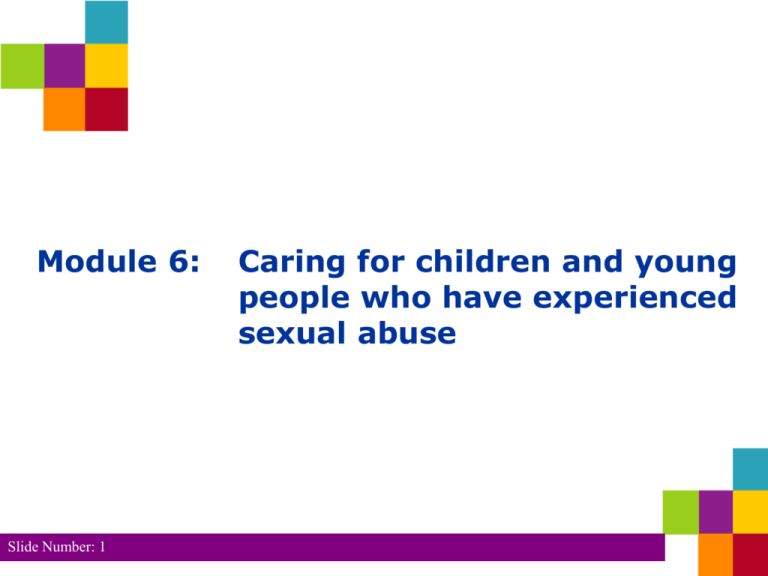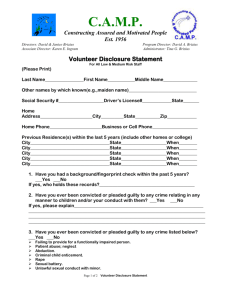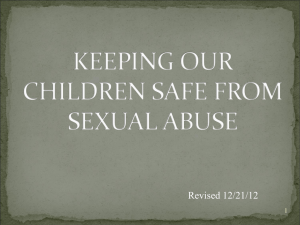
Module 6:
Slide Number: 1
Caring for children and young
people who have experienced
sexual abuse
Module 6: Caring for children and young people
who have experienced sexual abuse
Learning Outcomes
1. Understanding the signs and signals children and young people may
exhibit when they have experienced sexual abuse.
2. Understand the impact of sexual abuse on a child or young person and
their behaviour.
3. Demonstrate enhanced knowledge and skills in caring for children who
have experienced sexual abuse.
4. Demonstrate an increased understanding of the role of professional
and other support services.
Content
1. What is child sexual abuse?
2. Impact of sexual abuse.
3. Managing sexual behaviours.
4. Services and professionals that can help.
Slide Number: 2
Sexual abuse can include:
Kissing or holding a child in a sexual manner;
‘Flashing’ or exposing a sexual body part to a child;
‘Spying’ on children in bathrooms or bedrooms etc;
Speaking to children about sexual matters;
Obscene phones calls, remarks or emails to a child or young person
Fondling of a child or young person’s body in a sexual manner;
Persistent intrusion into a child’s privacy;
Penetration of the vagina or anus by a finger, penis or any other object;
Showing pornographic films, magazines or photographs to a child;
Oral sex;
Rape;
Incest;
Having a child pose or perform in a sexual manner;
Forcing a child to watch a sexual act and/or child prostitution.
Slide Number: 3
Normal Sexual Development
Ages 0-5 - children are curious about their bodies, children enjoy
being naked, masturbation is a self-soothing and exciting
behaviour, children engage in exploratory looking and touching
each others’ genitalia and this is accompanied by giggling and
amusing - no coercion. (Pithers, Gray, Cunningham & Lane 1993)
Ages 6 - 10 - continue exploration of bodies ie ‘doctor’ game or
“I’ll show you mine if you show me yours”, boys may compare
penis size, dirty jokes and sex words, limited interest in the
opposite sex. (Pithers et al 1993)
Ages 11 - 12 - masturbation, kissing and fondling with peers,
some imitation of sexual behaviours seen or heard about, some
sexual activity with own gender, always consenting activities with
peers. (Pither et al 1993)
Slide Number: 4
Signs and Signals
Blue Green Red -
indicates a possibility that sexual
abuse occurred;
indicates sexual abuse likely to have
occurred;
High probability of sexual abuse
occurred.
Adapted from The Protectors’ Handbook: Reducing the risk of child sexual abuse and
helping children recover by Gerrilyn Smith, London: The Women’s Press, 1995.
Slide Number: 5
Signs and Signals
Blue - A possibility that sexual abuse occurred
Under 5’s
Developmental
regression
Hostile/aggressive
behaviour
Psychosomatic
conditions
(physical
conditions
aggravated by
mental stress)
Slide Number: 6
12+ years
5-12 years
Abdominal pains
Developmental
regression
Peer problems
Psychosomatic
conditions
School Problems
Depression
Anorexia
Peer problems
Authority problems
Delinquency
Psychosomatic conditions
Signs and Signals
Green - Sexual abuse likely to have occurred
5-12 years
Under 5’s
Terror men/man (one
person)
Nightmares
Chronic
urinary/vaginal
infections
Soreness of
genitals/anus
Fear of being bathed
Fear of being
changed
Slide Number: 7
Soreness of
genital/anus
Chronic
urinary/vaginal
infections
Obsessional washing
Depression
Enuresis (bed-wetting)
Encopresis (faecal
incontinence)
Anorexia (eating
disorder)
Truanting
Nightmares
Unexplained large
sums of money/gifts
12+ years
Sexual boasting/stories/jokes
Sexually transmitted diseases
Pregnancy
Sexual offending
Rebellious against men
(specific gender)
Drug and alcohol abuse
Suicide attempts
Self mutilation
Hysterical symptoms
Obsessional washing
Psychotic episodes
Continual lying
Truanting
Running away
Signs and Signals
Red - High probability of sexual abuse occurred
Under 5’s
Disclosure
Genital injuries
Sexually transmitted
diseases
Vivid details of sexual
activity (such as
penetration, oral sex,
ejaculation)
Compulsive
masturbation
Sexual drawings
Sexualised play usually
acting out explicit sexual
acts
Slide Number: 8
5-12 years
Disclose
Genital injuries
Sexually transmitted
diseases
Sexual stories/poems
Exposing themselves
Masturbation in
contextual
inappropriate fashion
Sexually active
Suicide attempts
Running away
Alcohol and drug
abuse
12+ years
Disclosure
Genital injuries
Self mutilation of
breasts/genitals
Pregnancy
Sexually transmitted
diseases
Prostitution
Criterion for Differentiating Between Normal
and Problem Sexual Behaviours
Is the sexual activity developmentally appropriate
Do the children involved have equal power
Was it forced or was intimidation use
Was it kept a secret
Is the behaviour compulsive, is the child obsessed with it
(Pithers et al 1993)
Slide Number: 9
Key questions carers can ask prior
to the placement
Has the child experienced sexual abuse (whether the victim or
person responsible)?
What was the nature/extent of the sexual abuse?
What was/is the impact on the child I.e. needs or behaviours?
What was the offenders relationship to the child?
When did it happen?
Where or under what circumstances did it happen?
Has the child attended therapy or other support services?
Are there any significant safety issues likely to impact on the child
or young person subject to placement, other children or young
people in the carer home and carers or other members of their
family residing in the home?
How does the child or young person interpret or view their
experience of abuse e.g. blame themselves?
Slide Number: 10
Communication strategies
Some communication strategies to try with a child or young
person who has been or is likely to have experienced sexual
abuse include:
ensuring the child’s behaviour is verbalised into words so that
the child can develop appropriate levels of understanding;
telling the child you want to help him/her, make suggestions
and/or ask the child for their own ideas regarding what to do;
if the behaviour is destructive or damaging, be clear about the
consequences and set clear limits;
notice what triggers reactions in the child, including what calms,
soothes, arouses, angers and relaxes him or her, try developing
different routines, eg bath times, etc..
Slide Number: 11
Examples of what foster carers could say
to a child
I’m sorry you feel so bad about things.
I want to help you with this because it gets you into trouble
Perhaps you could have a space in the garden where its OK to express
these feelings without anybody getting or feeling hurt. What do you think?
I would like you to feel safe.
When do you feel safe and comfortable?
How can we help you feel like this more often?
I understand you feel the need to touch yourself but it is more respectful
to yourself and other people to do it in private in your own room when
you do, and/or maybe I could help you find something else to do instead?
We don’t kiss or touch each other like that.
You can hug me or kiss me like this (demonstrate appropriate affection).
I like it when you show me love and affection this way.
Slide Number: 12
When a child discloses abuse or neglect
Be a listener not an investigator - encourage children to talk in their
language and ask just enough questions to act protectively, say “can you
tell me more about that?”. Do not conduct any form of interview with the
child;
As soon as possible after the disclosure make written notes including
when and where the disclosure took place. Pay attention to body cues
such as changes in their behaviour, feelings, and words they used;
Be calm and reassure the child or young person that it is alright to talk
about this and they have not done the wrong thing.
Do not make promises you can’t keep, for example promising
you will not tell anyone, as you need to tell someone in order
to get help for the child;
Slide Number: 13
(cont.)
Tell the child or young person that you will need to talk to their
CSO. You should engage the child or young person in this – eg
say this information needs to be shared with someone and ask
how you can both do this.
Believe what the child or young person is saying and demonstrate
that you are taking it seriously.
It is vital to call even if you do not have all the details.
Slide Number: 14
Important points to remember
Keep information confidential. Only those who absolutely need to
know should be told. If in doubt about who to tell, seek advice
from a Departmental officer or care service staff.
Do not notify the individual against whom an allegation or
complaint has been made, regardless of who this person is. Leave
this to the Police and/or the Department.
Slide Number: 15
Creating a safe environment
Clear rules and expectations of behaviour, both inside and
outside the home, will include:
Some simple rules that allow for the child and adults to make
physical contact in a way that is experienced as “safe” or nonthreatening by the child;
A code of behaviour for everyone in the household about the
use of bathrooms, toilets and bedrooms, and privacy in
relation to dressing and clothing;
A listening environment;
Teaching a child the difference between secrets, surprises and
privacy;
Slide Number: 16
(cont.)
Teaching the correct and appropriate words for body parts and
behaviours;
Teaching the child to recognise his or her own feelings and
strategies for managing them;
Always asking the child’s permission before taking
photographs/video tapes; and
Living in an arena of safety – carrying out a safety audit and
reviewing it regularly
Reference: Hellett, J. with Simmonds, J (2003) ‘Parenting a child who has been
sexually abused’ BAAF, London
Slide Number: 17
Services and professionals that can help
Individual counselling;
Group therapy;
Empowerment, protective behaviour groups or safety
education;
Sexual Abuse Counselling Service; and
Telephone helplines.
Slide Number: 18
In conclusion
‘We all have to learn to go ahead as a team - stage by stage learning from experience - searching all the time for anything
new that we can learn about sexually abused children. Sometimes
we will have to accept that there are no easy answers. None of us
can justify not using the experience that we have acquired. I say
to professionals ‘You must be there by our side as we move
forward - listening, talking, learning - that is the only way to keep
walking forward together.’
An experienced foster carer.
Slide Number: 19







